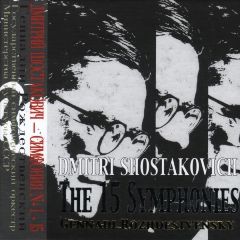Dmitri Shostakovich - Symphony no.10 (Rozhdestvensky) [1986]
Dmitri Shostakovich - Symphony no.10 (Rozhdestvensky) [1986]

1. Moderato 2. Allegro 3. Allegretto 4. Andante – Allegro USSR Ministry of Culture Symphony Orchestra Gennady Nikolayevich Rozhdestvensky – conductor
Symphony No. 10 in E minor, Op. 93.
This was Shostakovich's first symphony in eight years, and the gap between this and the 1945 Ninth owed nothing to a lack of inspiration in the genre. In 1948, Shostakovich, Prokofiev, Khachaturian, and other noted Soviet composers were censured for writing what party censors called "formalistic" music, a code word for dissonance and the expression of negative emotions or cynicism. Of course, examined against such vague and, therefore, potentially all-inclusive standards, virtually any composition could be vulnerable to attack, and many of Shostakovich's were singled out. After January 1948, most Soviet composers were simply unsure of what was safe to write. Shostakovich turned to writing patriotic bombast like the choral work Song of the Forests (1949), the cantata The Sun Shines on Our Motherland (1952), as well as vapid film scores like that for the 1950 release The Fall of Berlin.
On March 5, 1953, Stalin died. The stringent policies in the arts loosened somewhat in the aftermath of the dictator's passing, and Shostakovich seized the opportunity to write a large symphony, not least because he could satirize Stalin in it. In fact, the second movement is said to be a depiction of the Soviet tyrant. The music in this Allegro is angry and intense, but also quite Russian. Certainly, it can be heard as austere and hostile, sinister and threatening, thereby painting an effective and credible portrait of Stalin, but it might also express anxiety and fear, emotions hardly new to Shostakovich. Thus, the "Stalin" interpretation of this movement, while quite possibly valid, is not fully convincing, much less verifiable.
The Symphony No. 10 opens up with a Moderato movement that is nearly as long as the ensuing three movements combined. The mood is dark and brooding and the structure is not unlike that of the Eighth's opening section: there is an introductory theme, followed by two "main" themes. Here, the second of those is faster than its counterpart in the Eighth, and while the atmosphere is intense in the exposition and development section, there is a relaxation in intensity in the recapitulation and coda, where the Eighth remains mired in darkness.
As suggested above, the second movement is a biting, sinister piece. It is followed by an Allegretto of decidedly Russian character, whose mood brightens somewhat, especially in the middle section. This movement is notable because it is the first time that Shostakovich used his personal motto, D-E flat-C-B, which, via German transliteration, represents his initials, DSCH. This motif would appear in numerous subsequent works by the composer, like the Violin Concerto No. 1 (1947-1948; rev. 1955) and his popular String Quartet No. 8 (1961).
The finale starts off with an Andante that seems mired in a slow-motion haze. Suddenly the mood turns joyous and playful, lively and colorful. An austere middle section recalls the opening gloom, but the cheerful music returns and the symphony ends in a blaze of ecstatic joy. The Symphony No. 10 was premiered in Leningrad on December 17, 1953, under the baton of Yevgeny Mravinsky. It has become, with the Symphony No. 5, Shostakovich's most often performed and recorded symphony. --- Robert Cummings, Rovi
download: uploaded yandex 4shared mediafire solidfiles mega zalivalka filecloudio anonfiles oboom
Zmieniony (Piątek, 09 Maj 2014 13:21)








